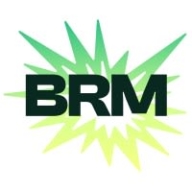

PayShepherd and BRM are competing in the tech solution market. PayShepherd has an advantage in pricing and support, while BRM offers superior features that justify its cost to tech buyers.
Features: PayShepherd provides robust financial tracking, efficient transaction management, and caters to budget-conscious firms. BRM offers advanced analytics, integration capabilities, and extensive data insights.
Ease of Deployment and Customer Service: PayShepherd offers straightforward deployment and responsive customer service, appealing to smaller firms. BRM's complex implementation requires resources but provides comprehensive support for larger enterprises.
Pricing and ROI: PayShepherd's lower setup costs and swift ROI are attractive for limited budgets. BRM, with higher initial costs, offers longer-term ROI appealing to organizations investing in advanced features.
BRM is designed to streamline business resource management by offering a seamless integration of processes and data within organizations, enhancing communication and efficiency.
BRM serves as a comprehensive tool for organizations aiming to optimize their business processes. It offers valuable features that cater to needs such as data management, resource allocation, and process automation. Implementing BRM can lead to improved operational efficiency, better resource tracking, and enhanced decision-making capabilities. While powerful, BRM provides room for improvement in its integration capabilities with third-party systems, offering potential for expanded functionality.
What are the key features of BRM?BRM implementation varies across industries like manufacturing, healthcare, and finance, adapting to the specific process needs. In manufacturing, it helps in effective resource planning and inventory control, while in healthcare, it improves patient data management and service delivery. In finance, BRM aids in financial data analysis and reporting, boosting efficient financial planning.
PayShepherd manages invoicing, streamlines payment processes, and tracks project costs. Known for reducing administrative tasks, improving financial accuracy, and enhancing transaction transparency, its intuitive design simplifies financial workflows for teams.
PayShepherd is regarded for efficiently simplifying complex financial workflows, enabling better resource allocation, and financial oversight. Users value its intuitive navigation and features designed to manage invoicing, payment processes, and project cost tracking. With customization options and seamless software integration, it becomes a robust tool for managing financial operations. The solution's emphasis on real-time project tracking, detailed cost management, and a user-friendly dashboard allows for easy adoption and effective use. Despite some performance issues, slow response times, and occasional data synchronization inconsistencies, it remains a preferred choice due to its simplified financial workflow capabilities.
What are the key features of PayShepherd?In specific industries, PayShepherd can significantly streamline processes within construction, manufacturing, and professional services. It helps manage invoicing, payment processing, and project cost tracking, ultimately reducing administrative burdens and ensuring financial data accuracy. By integrating with existing industry software, it offers enhanced reporting and analytics tailored to industry-specific needs.
We monitor all Procurement Software reviews to prevent fraudulent reviews and keep review quality high. We do not post reviews by company employees or direct competitors. We validate each review for authenticity via cross-reference with LinkedIn, and personal follow-up with the reviewer when necessary.